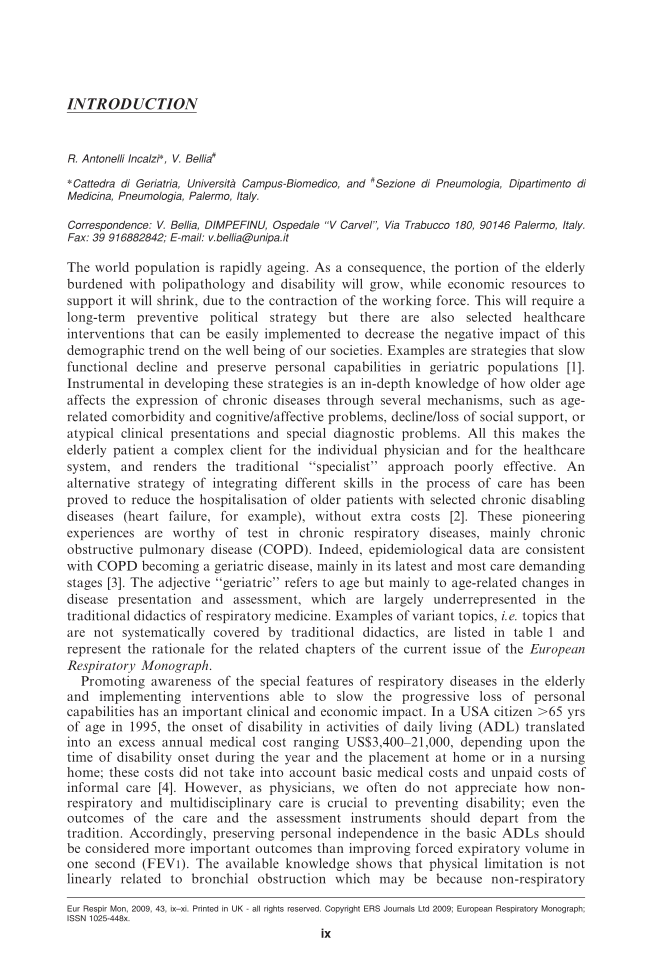INTRODUCTION R. Antonelli Incalzi*, V. Bellia# *Cattedra di Geriatria, Universita `Campus-Biomedico, and #Sezione di Pneumologia, Dipartimento di Medicina, Pneumologia, Palermo, Italy. Correspondence: V. Bellia, DIMPEFINU, Ospedale ‘‘V Carvel’’, Via Trabucco 180, 90146 Palermo, Italy. Fax: 39 916882842 E-mail: v.bellia@unipa.it The world population is rapidly ageing. As a consequence, the portion of the elderly burdened with polipathology and disability will grow, while economic resources to support it will shrink, due to the contraction of the working force. This will require a long-term preventive political strategy but there are also selected healthcare interventions that can be easily implemented to decrease the negative impact of this demographic trend on the well being of our societies. Examples are strategies that slow functional decline and preserve personal capabilities in geriatric populations [1]. Instrumental in developing these strategies is an in-depth knowledge of how older age affects the expression of chronic diseases through several mechanisms, such as age- related comorbidity and cognitive/affective problems, decline/loss of social support, or atypical clinical presentations and special diagnostic problems. All this makes the elderly patient a complex client for the individual physician and for the healthcare system, and renders the traditional ‘‘specialist’’ approach poorly effective. An alternative strategy of integrating different skills in the process of care has been proved to reduce the hospitalisation of older patients with selected chronic disabling diseases (heart failure, for example), without extra costs [2]. These pioneering experiences are worthy of test in chronic respiratory diseases, mainly chronic obstructive pulmonary disease (COPD). Indeed, epidemiological data are consistent with COPD becoming a geriatric disease, mainly in its latest and most care demanding stages [3]. The adjective ‘‘geriatric’’ refers to age but mainly to age-related changes in disease presentation and assessment, which are largely underrepresented in the traditional didactics of respiratory medicine. Examples of variant topics, i.e. topics that are not systematically covered by traditional didactics, are listed in table 1 and represent the rationale for the related chapters of the current issue of the European Respiratory Monograph. Promoting awareness of the special features of respiratory diseases in the elderly and implementing interventions able to slow the progressive loss of personal capabilities has an important clinical and economic impact. In a USA citizen .65 yrs of age in 1995, the onset of disability in activities of daily living (ADL) translated into an excess annual medical cost ranging US$3,400–21,000, depending upon the time of disability onset during the year and the placement at home or in a nursing home these costs did not take into account basic medical costs and unpaid costs of informal care [4]. However, as physicians, we often do not appreciate how non- respiratory and multidisciplinary care is crucial to preventing disability even the outcomes of the care and the assessment instruments should depart from the tradition. Accordingly, preserving personal independence in the basic ADLs should be considered more important outcomes than improving forced expiratory volume in one second (FEV1). The available knowledge shows that physical limitation is not linearly related to bronchial obstruction which may be because non-respiratory Eur Respir Mon, 2009, 43, ix–xi. Printed in UK -all rights reserved. Copyright ERS Journals Ltd 2009 European Respiratory Monograph ISSN 1025-448x. ix
